Known in botany for over 3000 years, Her Majesty The Lily is one of the most revered and, for many, the most beautiful flower in the world. With its fragrant, funnel-shaped blooms of irresistible elegance, Types of Lily flowers have always attracted attention, and tenderness and innocence have been their consecrated elements for thousands of years.

And although the word lily, for most, is associated with the fragrant flower of white petals, or Madonna lilies (Lilium Candidum), the versatile kingdom includes almost 90 species of plants and almost countless cultivars and hybrids of different colors and shapes of flowers.
But before we dive into the magical and fragrant world of different types of lilies, let’s say a few words about this plant’s characteristics and growing conditions.
What Is Lily?
Lilies are perennials with bulbs and aboveground stems belonging to the genus Lilium and the family Liliaceae.
Plants of this genus are widespread in the northern hemisphere’s temperate climates, and more than half of the species are of Asian origin.
You can see them in summer garden flower beds in many yards worldwide. In addition, their magnificent flowers are a classic element of flower arrangements, wedding bouquets, or table decorations, and some species, due to early blooming, are almost the symbol of Easter time.
Cat lily flowers stay fresh in vases for one to two weeks, and the blooming time for planted lilies last at least four weeks.
1. Lily Flowers
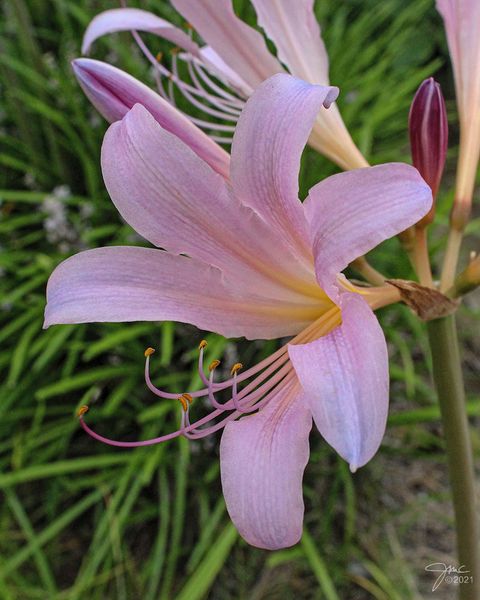
Lilies have flowers of exotic appearance, often with a rich scent, and offer a wide range of sizes, shapes, colors, blooms, and flowering times. They grow on erect, tall flower stalks, usually gathered in clusters or arranged alternately on the leafless top stalk. Each bulb usually gives just one flowering stalk.
The flowers usually have six petals and six easily prominent anthers with thin and long filaments. The shape of the flower depends on the species and can be tubular, turban-shaped (Turk’s cap-shaped), or vase-shaped. They can be erect (upward-facing flowers), horizontal (facing outwards), and hanging (downward-facing flowers).
Lily Foliage
The leaves of the flower are lanceolate, linear, or oval. They grow alternately or ring-shaped along the stem except at the apex, where flowering buds appear. The size of the leaves also depends on the species and can be two to four inches long. They are usually shiny, medium to dark green, with a pointed tip.
How To Grow Lilies?
Lilies are very hardy plants that can grow in the same place for years once planted in the garden. They do not require special treatment, contributing to their constant popularity.
However, this does not mean it will grow anywhere or in all conditions. Here’s what you need to pay attention to!
Light
Lilies prefer sunny or semi-shady positions. Like roses, they need at least six hours of direct sunlight a day and grow abundantly and profusely bloom when you place them in full sun.
Planted near tall shrubs or walls that keep them in the shade, they stretch and lean in an attempt to reach more light.
Soil
Lilies do not require any particular soil type and usually grow well in the average garden. What they do not tolerate is poor and soggy soil. Their bulbs do not have a protective shell as tulip and daffodil bulbs, and they are prone to rot if the ground is too wet.
Therefore, you can plant them in organic-rich, well-drained neutral soil. Before planting the bulbs, it is advisable to thoroughly prepare the soil by digging it to a depth of at least one foot.
Fertilizer
If you want your lilies to bloom profusely, you need to provide them with additional nutrition on two occasions: For the first time in the spring, as soon as the shoots appear and next time, six to eight weeks later, before the flower buds appear. You can apply a balanced liquid fertilizer with an NPK ratio of 10:10:10.
Water
If the rainfall is below one inch per week, your lilies will need extra hydration because arid soil is just as unfavorable as the soaked one. Therefore, feel free to water them at least once a week on hot summer days. Occasional spraying of the leaves also helps lilies stay fresh, significantly when growing in the full sun.
When And How To Plant Lilies
The best time for planting lily bulbs is early fall, but you could do it in the spring if you purchased them too late.
The general rule says to plant lily bulbs at a depth twice their height. The exception is Lilium Candidum (Madonna lily), which is always planted below the soil surface.
You can plant them in groups of three to five bulbs for best effect with a spacing of three times the bulb’s diameter. Depending on the lily type and the bulb’s size, the spacing is usually between 8 and 18 inches.
Lily Dormant Phase
Lilies are plants that come from continental regions, and as garden perennials that overwinter in the soil, you can grow them in climate zones 3 to 8.
The aboveground part of the plant dies in autumn, and the plant dies during the winter months. The arrival of spring, the temperature rise, and the soil warming will awaken the bulbs triggering new growth.
Therefore, it is good to mark where you planted the bulbs, especially in mixed beds, so as not to damage them as part of spring tillage, preparation of beds, or planting new plants.
In climate zones 9 and above, you should remove the bulbs from the ground in the fall and store them in a cool place for a few weeks. This kind of artificial cooling is necessary to simulate the natural environment in which these plants live. Without a significant temperature difference between the two seasons, the bulbs might not wake up or bloom next season.
2. Potted Lilies
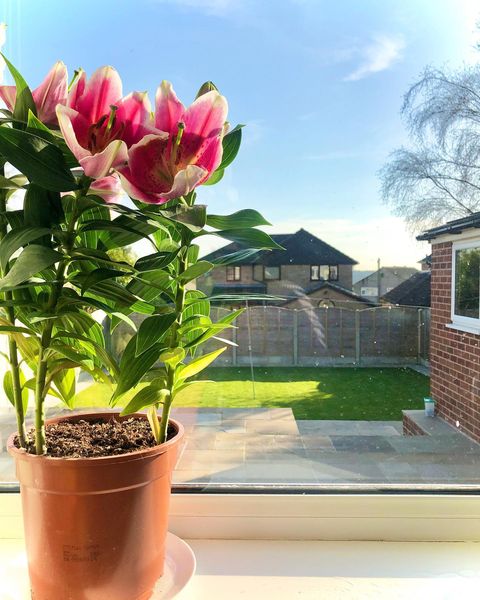
Today many dwarf cultivars have managed to retain the characteristics of their large relatives but do not grow higher than two feet and therefore are very suitable for growing in pots. However, you can plant even classic lilies in containers and enjoy their magnificent flowers and scent on the terrace or balcony.
The pot must be spacy, at least ten inches in diameter and the same depth, with openings at the bottom so excess water can drain away. At the bottom, you should place a layer of gravel to increase the drainage.
Depending on the pot size, you can plant a few bulbs in the same pot at a distance of at least five inches.
You should water and feed your potted lilies frequently. They respond well to liquid fertilizer for flowering plants, and you can apply it from the stem’s appearance until the buds’ formation.
The Symbolism Of Lilies
The lily as a symbol has different meanings. In Greek mythology, it is associated with the protector of marriage and offspring – the goddess Hera. Legend has it that lilies originated from drops of milk from the goddess Hera while breastfeeding Zeus’ son Hercules. According to old stories, a few drops fell to the ground, forming a white lily.
One of the Roman legends says that Venus saw a lily after rising from the sea foam and became full of envy and jealousy for the beauty and whiteness of this flower.
Yet the lily has left its most significant influence in Christianity, where it has long symbolized innocence and purity. Some stories mention how white lilies grew in the place where Jesus’ tears fell, but also that they appeared in the place where Eve shed tears of remorse. According to the Bible, the lily was the favorite flower of the Virgin Mary.
The lily is also associated with St. Anthony and symbolizes the purity he possessed, and on his feast days, blessed lilies are distributed in many places.
This flower is also a symbol of beauty and royal dignity and, at one time, was considered a sacred plant. It is mentioned several times in the Bible as a symbol of innocence and the most splendid beauty.
The lily was often used for health purposes, so the ancient Egyptians used it to treat diseases such as ear, lung, nervous system, bones and joints, and women’s diseases.
Classification Of Lilies
Numerous lily species and cultivars are classified in several ways according to the size, origin, fragrance, time of blooming, etc.
However, the North American Lily Society developed the most often used and officially recognized system.
It is not a botanical but a horticultural classification, used in exhibitions and catalogs of lilies. The classification organizes lilies into ten main groups, according to the origin, and further into subgroups based on the shape of the flower.
Another very commonly used classification is one created by the Royal Horticultural Society, which classified lilies into nine divisions or groups.
This classification includes wild or species lilies and cultivars formed by combining plants of different origins.
Different Types Of Lilies
Yet, let’s leave the classification to botanists and professional growers because, for most amateur gardeners and lovers of this flower, it may not matter which group or division your favorite lily belongs to. That is why we bring you the essential characteristics of indigenous and hybrid species below so that when you buy lily bulbs, you know when it blooms and how high the plant will grow.
Wild Lilies
The story of lilies, of course, begins with native plants since they served as the basis from which growers created an almost endless list of cultivars and hybrids.
Although their cultivated descendants have surpassed them in beauty and popularity, it is undeniable that many of them are still desirable plants worth growing in the garden.
In addition, as indigenous species that grow without human intervention, if you place them in an acceptable environment, these plants will reliably develop, spread and bloom from year to year.
3. Canada Lily (Lilium Canadense)
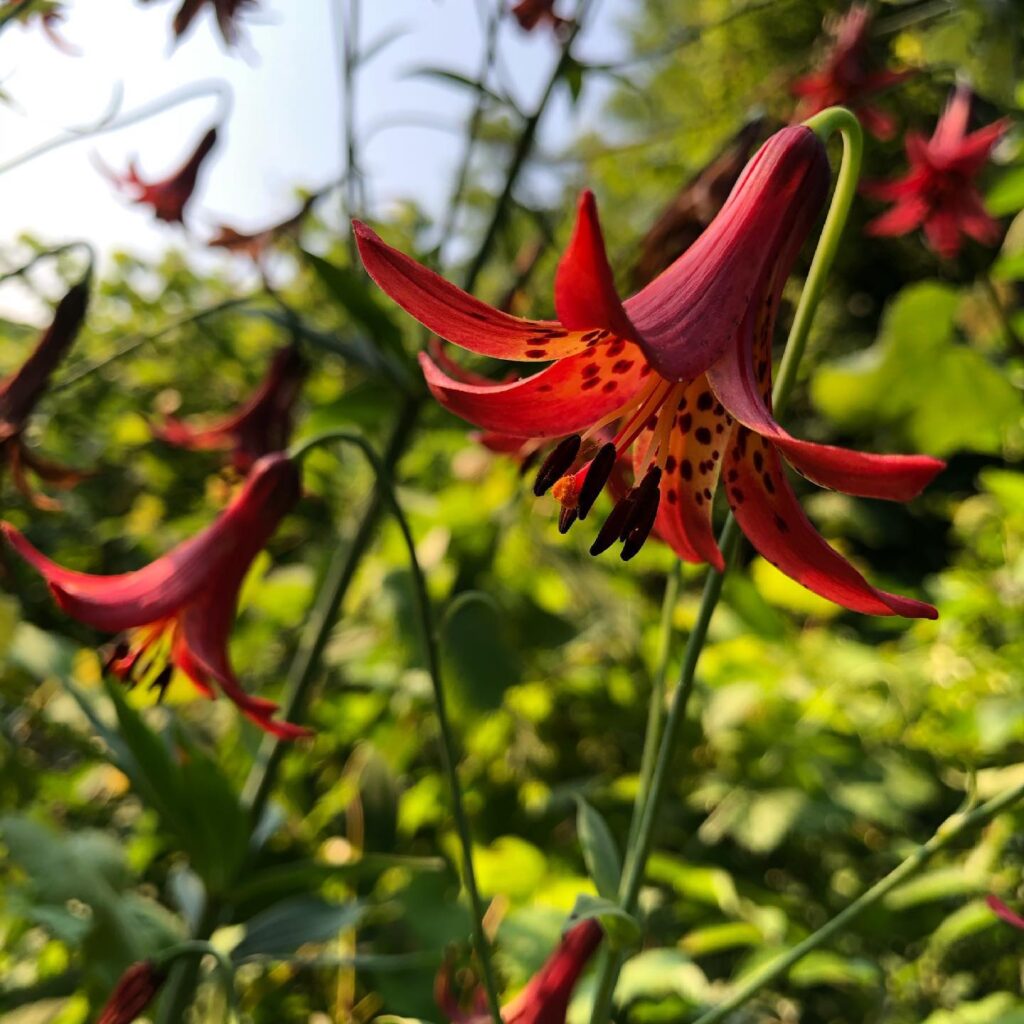
Native to North America from Quebec to Nova Scotia, south to Georgia, the Canadian lily is a showy wild lily that blooms during early to mid-summer, with striking, hanging yellow, red, or bright orange flowers with dark dots at the base of the petals.
The plant is three to six feet tall in the flowering phase because the flowers with outwardly curved petals appear on high stalks above the lanceolate leaves. Each plant produces 16 to 20 flowers. The plants are lovely in group planting when their flowers look like they are swaying above the leaves.
The Canadian lily belongs to the group of odorless lilies but is a valuable food source for many insects and small birds. Its bulbs and flowers used to be part of the Native American diet.
This plant loves moist and sunny habitats and soil rich in organic material. In nature, it grows on the edges of forests and wet meadows, so try to provide it with similar conditions in the garden. Unfortunately, in unfavorable surroundings, the plant will not bloom!
4. Martagon Lily (Lilium Martagon)

Martagon lily is an impressive wild plant with downward-facing, two to four inches in diameter long flowers and petals so bent that they almost touch the flower stalk. Due to this flower form, the plant is often called Turban lily or Turk’s cap lily.
The most common Martagon lily gives pink or soft purple flowers, often highlighted with dark spots. The variant with pure white or albino blooms is much rarer.
This plant comes from the Eurasian area and is highly resistant to low temperatures.
Unlike many other species of lilies, it is a shade-tolerant type that blooms profusely even when growing in partial shade.
Its sophisticated flowers appear in mid or late summer, are not fragrant, or have a slightly unpleasant odor. Several flowers rise above the dark green whorled leaves on one stalk.
The plant grows three to six feet in height, is a long-lived perennial, and can be kept in the garden for decades. It is an excellent choice for those who prefer an old cottage-style garden with a touch of untamed nature.
5. Leopard Lily (Lilium Pardalinum)
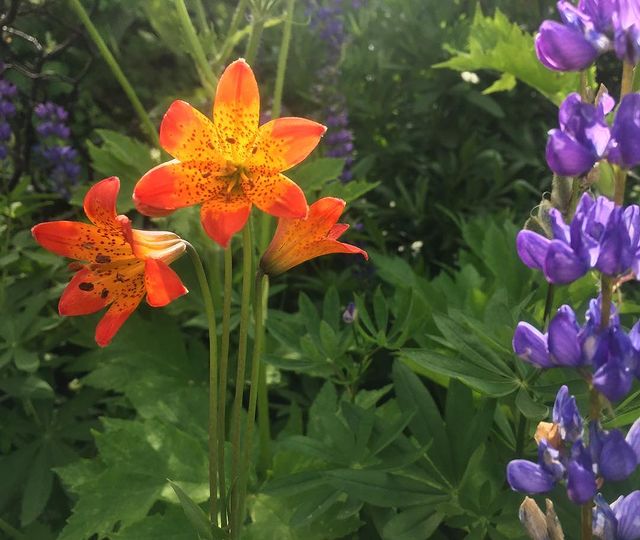
Gorgeous Leopard lilies with the scientific name Lilium Pardalinum are wild lilies from Oregon and Baja California in North America. They grow in damp areas, often on creek banks or around swamps.
These bulbous perennials grow from six to eight feet high and 15 inches wide and belong to the group of mid-summer flowering lilies.
Its three inches in diameter long and showy, turban-shaped fragrant flowers combination of orange and yellow with dark spots usually appear during July. Distinctly dotted petals inspired the name of this plant, Leopard lily and Panther lily.
The plant spreads by rhizome creeping bulbs forming stunning colonies. They are excellent as a cut flower because they can retain freshness for up to seven days.
Interesting, but if you have a cat, avoid planting this flower because it is toxic to cats. It is, however, harmless to dogs, humans, or other animals.
6. Tiger Lily (Lilium Lancifolium)
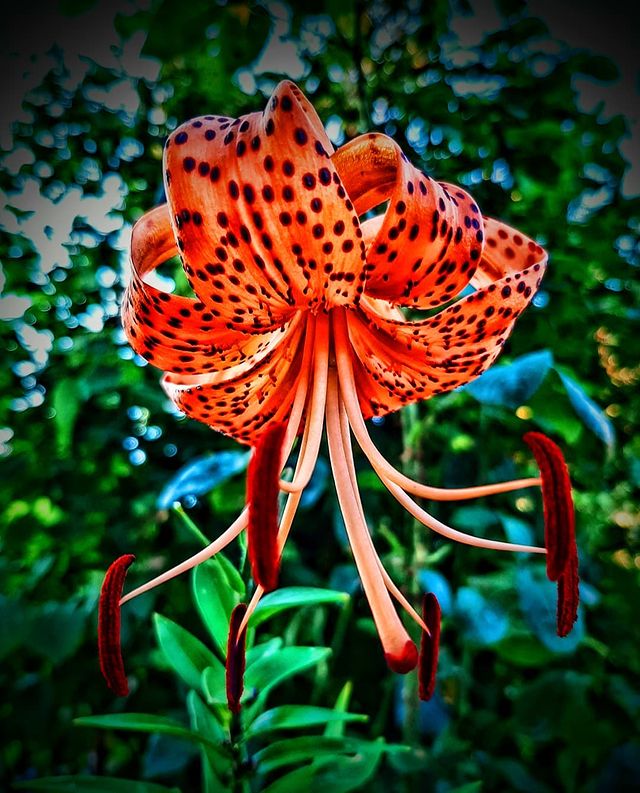
These originally Asian native lilies are widely naturalized in other parts of the world, especially in the USA and the UK.
The three inches wide, bright orange flowers covered with dark purple spots appear on tall, dark brown stamens in mid to late summer. The six petals that make up the flower are gracefully recurved petals toward the petiole, revealing five long anthers.
The vigorous Tiger lilies can grow three or four feet tall, gradually forming dense clumps of dark green, six inches long leaves above which the gorgeous flowers rise. In the axils of the leaves, the plant forms bulbils or small bulbs that you can separate and grow new plants.
Although it does not belong to the fragrant lilies, the Tiger lily is widespread since this eye-catching type is not picky or demanding to grow.
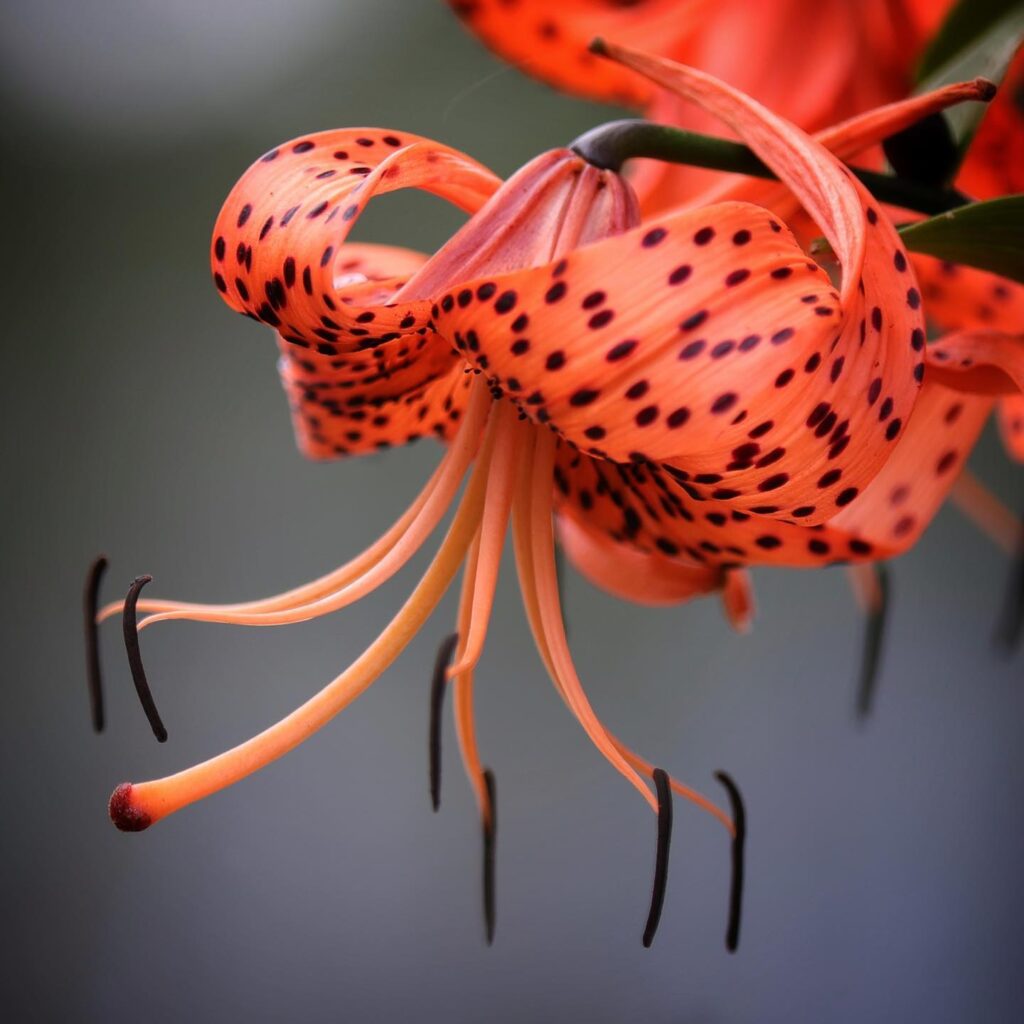
Double Tiger lily stands out among the other varieties giving the excellent shaggy flower performance, such as irresistible ‘Flore pleno’ with 24 to 36 orange petals sprinkled with dark spots.
7. Madonna Lily (Lilium Canadinum)
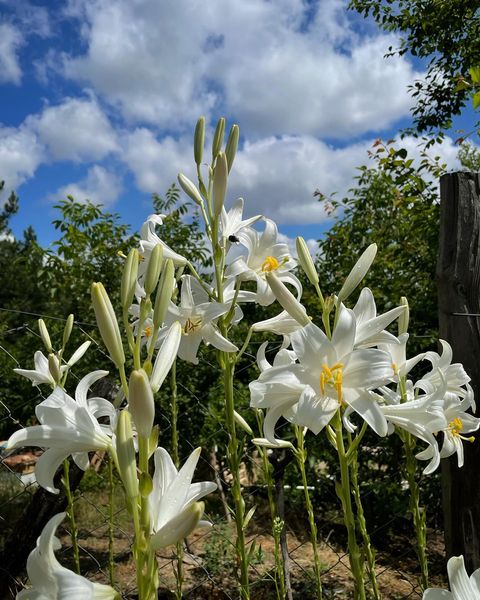
A native plant of the Balkans and the Middle East, the Madonna lily is one of the most famous representatives of the lily family.
The adjective ‘Candidum’ in its Latin name comes from the word ‘white,’ so this plant, which many legends have been told about, was synonymous with purity even in pre-Christian times. Its magnificent and fragrant, trumpet-shaped flower in pure white color has aroused admiration for almost 3000 years. Therefore this plant is naturalized in many parts of the world, far from the region of its origin.
Unlike the other lilies, Madonna lilies bloom early, starting in late spring, giving the famous heavily scented flowers on the top of three to four feet tall stems. Each stem bears 10 to 20 snow-white flowers with intense yellow anthers.
Madonna lily prefers the full sun to partial shade positions and well-drained, organic-rich soil.
8. Oriental Lily (Lilium Speciosum)
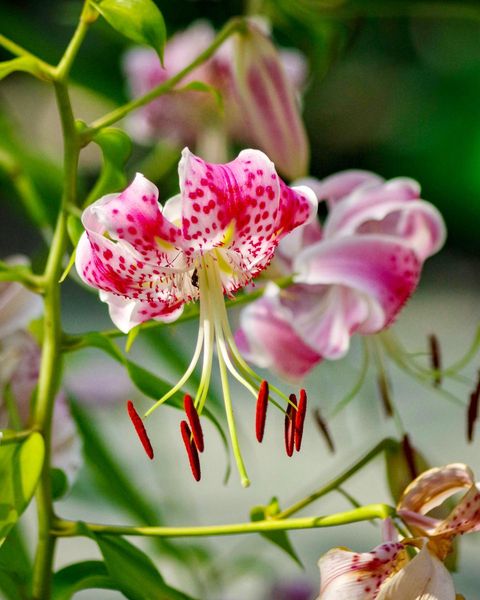
The real eye-catcher, Lilium speciosum or Oriental lily, is a native lily type from Southern Japan and China, where it grows in areas of 600 m to 900 m above sea level.
The plant has hanging flowers three inches in diameter with recurved petals in white or shaded pink. The characteristic bumps or ‘papillae’ pink or dark purple give the flower a unique charm and make it recognizable among lily flowers.
Oriental lily is a very fragrant species and one of those that will delight you with its flowers just before the end of the season. Namely, unlike many other lilies, this three-foot-tall lily flower blooms in late summer or early fall.
Oriental lilies are late flowering types of lilies. The flowering performance starts in late summer or at the beginning of fall. The flowers come in different shades of white, yellow and pink and are usually a combination of these colors.
9. Golden-rayed Lily (Lilium Auratum)
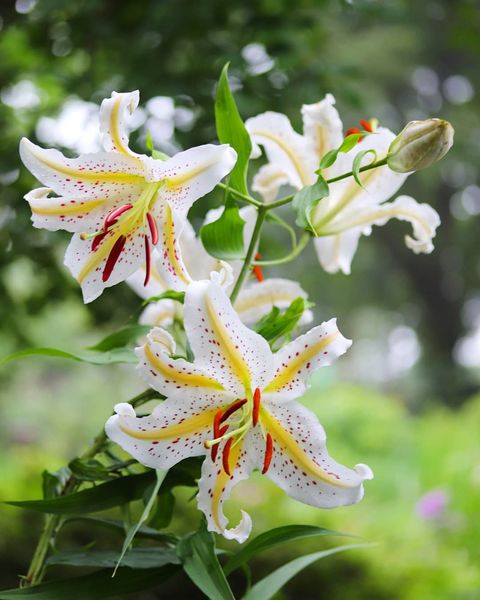
Another beautiful wild lily native to Japan, the Lilium auratum, with large bowl-shaped flowers, served as the basis for creating many cultivars. Its flowers are white, 10 inches in diameter and each of the six recurved petals is decorated with a central yellow line and sprinkled with crimson dots.
The flowers open in mid-summer and release a pleasant spice-like scent. Each solid three or four-foot-tall stem bears on the top 12 to 14 alternately arranged flowers.
It is not difficult to grow as long as the soil is neutral to acidic and if you provide it with well-drained soil, full sun, and regular watering.
10. Henry’s Lily (Lilium Henryi)

Originating from the mountains of central China, Henry’s lily or Lilium Henryi will charm you with clusters of fragrant orange turban-shaped flowers with chestnut bumps on the petals.
The plant is four to six feet tall and spreads two to four feet. Many fragrant flowers appear in mid-summer and stay fresh for a long time, so the flower show lasts for several weeks.
This wild lily that likes full sun positions has made it possible to create many cultivars and hybrids that you can grow in slightly alkaline soil. Some famous hybrids and notable cultivars, such as the Trumpet or Oriental lilies, were created by crossing this robust indigenous plant with other types of lilies.
11. Orange Lily (Lilium Bulbiferum)
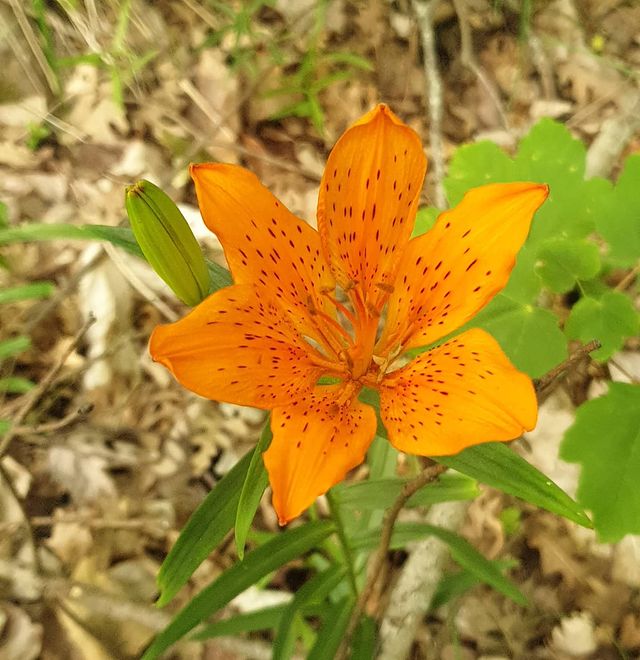
Orange lily or Fire lily is a native European species. The bulb is ovoid, strongly developed, and built of numerous fleshy, whitish, or yellowish scales arranged like roof tiles. The stem is erect, with reddish-black spots, hairy in the upper part. It grows one to three feet tall.
In the middle of the stem grow densely alternating, linear, bare, and glossy leaves up to three inches long. In the axils of the leaves, there are round, yellowish-green bulbs.
The flowers are bisexual, erect, large, funnel-shaped, odorless, solitary, or clustered two to five at the tips of the stems. The flower has six reddish-orange petals, one-and-a-half to two inches long, with reddish-brown spots on the inside and bent at the top back. The anthers are half shorter than the petals, and their anthers are dark red. It blooms in early summer during June.
12. Easter Lily (Lilium Longiflorum)
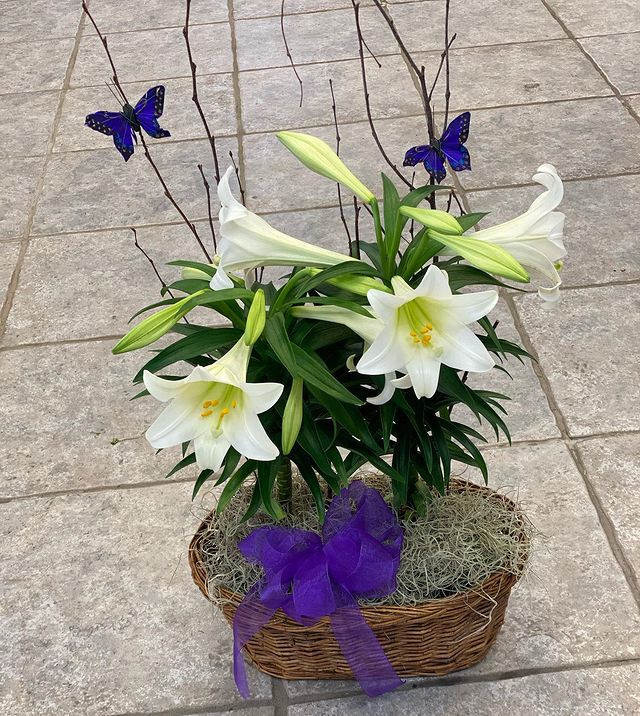
While the vast majority of lilies are winter-hardy in the continental regions starting from zone 2 onwards, the delicate and refined Easter lilies cannot overwinter in the soil in colder areas.
This type of lilies can be grown as a garden perennial in climate zone 5 or higher. If you do not live in that climate, it is best to dig up the bulbs in the fall when the leaves withered and store them in a frost-free area.
Easter lilies have recognizable white or creamy-white flowers that grow on three to four-foot-tall stalks.
The plant blooms in the spring at Easter in warmer regions, which explains its common name. The Easter lily delays flowering in colder regions until the soil warms up nicely and blooms mid-summer. The plant needs full sun to bloom and well-drained and fertile soil. It can grow in light shade, but it will bloom later and give fewer flowers.
If you want to learn more about the most popular lily varieties, check out the video below!

Hybrid Lilies
The fact that the genus of lilies has almost 90 species and over 2000 varieties has enabled the creation of numerous stunning hybrids whose beauty or scent is breathtaking. But, this process is still going on, so novelties are constantly appearing on the market, offering incredible shades and color combinations.
Asiatic Hybrids
As the name says, Asiatic lilies are a combination of different Asian indigenous species. Their characteristic feature is early flowering and ease of cultivation, which is why they are prevalent in many gardens. They begin to bloom in late spring and, similar to most lilies, love full sun position and nutritious and porous soil.
If this almost perfect, cup-shaped, three to four inches long flower has a drawback, it is the absence of fragrance.
However, Asiatic hybrids make it up with many colors, including all possible shades except blue.
Their bright flowers suit any garden scheme, and the choice of colors can satisfy everyone’s taste.
13. Martagon Hybrids
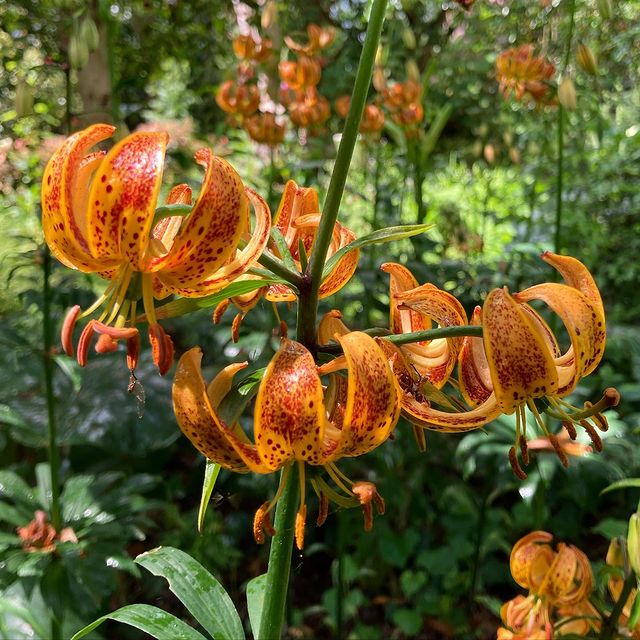
Unlike Asian hybrids, martagon hybrids have turban-shaped flowers up to three inches in diameter. They are slightly taller, reaching six feet.
Martagon hybrids bloom in late spring and early summer with yellow, white, orange, brown, purple, or lavender flowers. They prefer a cooler climate and do not thrive well in a hot and humid environment.
14. American Hybrids

American hybrids are derived from native North American lilies. Most of them originated from the species Lilium Pardalinum or Leopard lily, which is why they have hanging flowers.
The plant grows three to four feet tall, while the flowers have a diameter of three to five inches. The flowers are usually sprinkled with dark spots and more or less outwardly curved petals. They appear in late spring and early summer.
Hybrids from the Bellingham series are trendy due to their fiery-colored petals, maroon dots, and striking orange anthers.
15. Longiflorum Hybrids

These hybrids result from a cross between the famous Lilium longiflorum (Easter Lily) and Lilium formosanum. They bloom in mid-summer and have white or creamy white fragrant trumpet-shaped flowers.
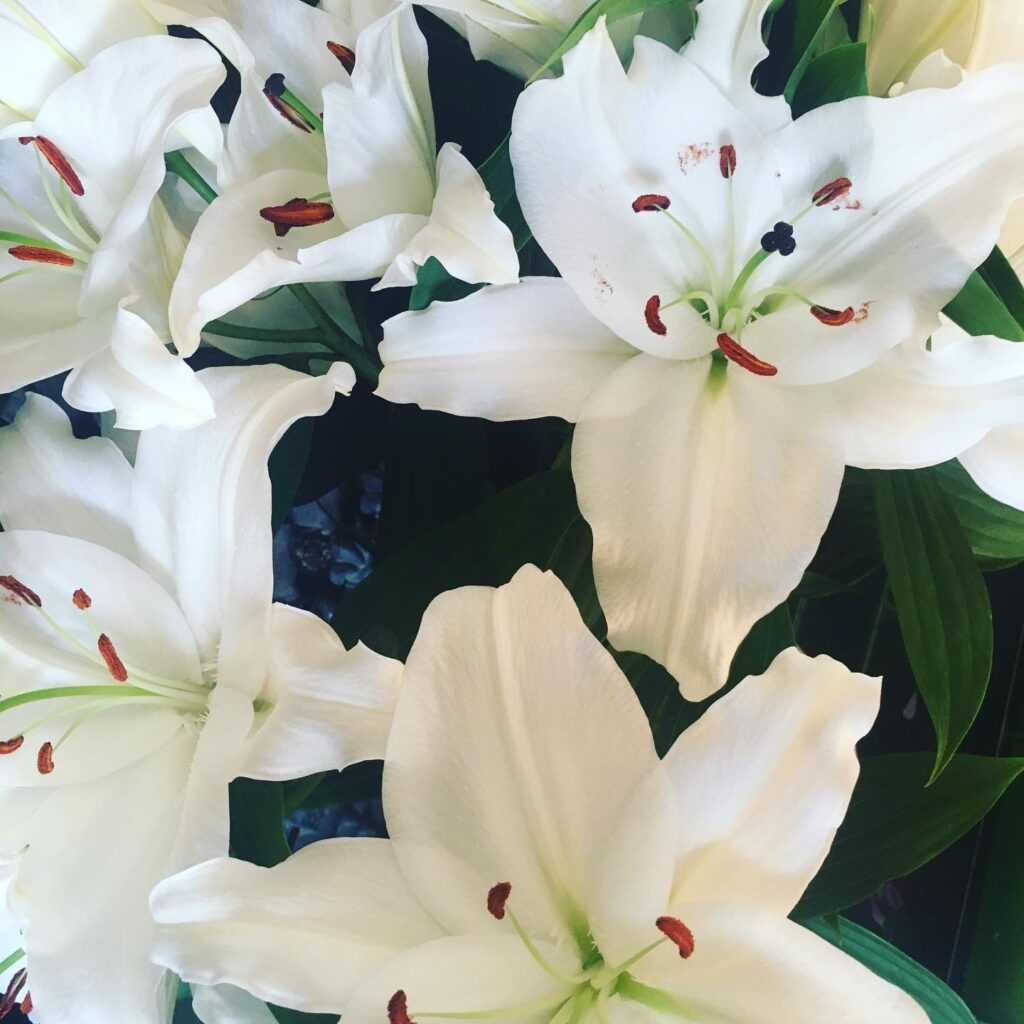
Like the species from which they originated, Longiflorum hybrids are sensitive to low temperatures and grow best in climate zones 7 or higher. Therefore it is best to grow them in containers in cooler climate zones. You can choose from many varieties, but ‘White haven’ and ‘White America’ are among the most favorite.
16. Trumpet And Aurelian Hybrids
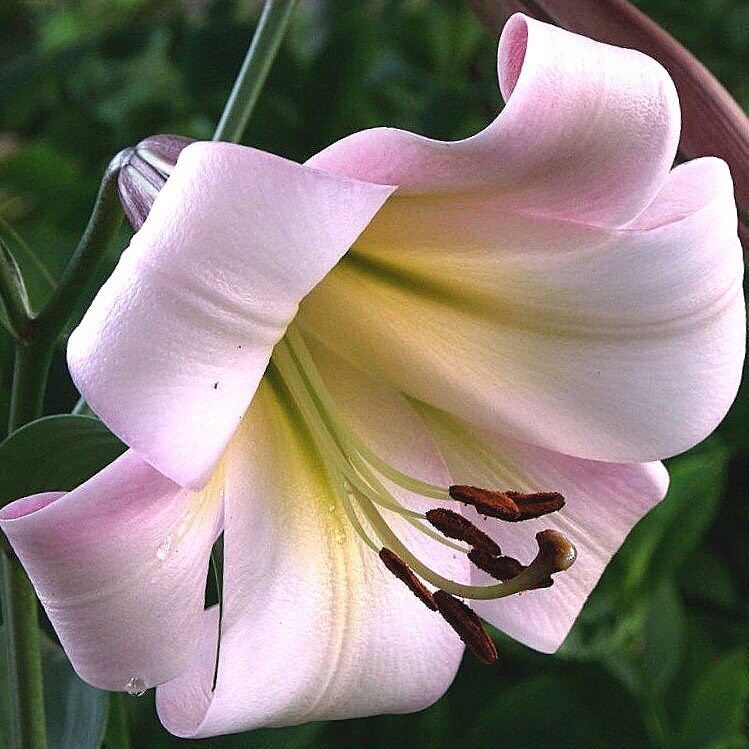
Trumpet lilies have characteristic large waxy flowers that can grow up to 10 inches in length until the whole plant reaches five or six feet. The trumpet flowers can be pendant or upward facing with slightly recurved petals and release an intense scent.
The flowers’ colors are different: pure white to bright yellow, orange, apricot, or plum-colored. Each bulb gives one stem on which 10 to 15 flowers develop. Trumpet lilies belong to the group of late-flowering lilies because the flowers open in mid or late summer.
Due to the size and elegance with which the flowers exude and the intense scent, these magnificent plants always attract attention and cause admiration.
Despite their size, as a focal point, Trumpet lilies easily fit into any garden scheme and are a great cut flower because they stay fresh in vases or bouquets for a long time.
Some of the most famous trumpet lily hybrids are ‘Golden splendor’ with stunning golden yellow flowers and ‘African Queen’ with striking bright orange blooms.
17. African Queen
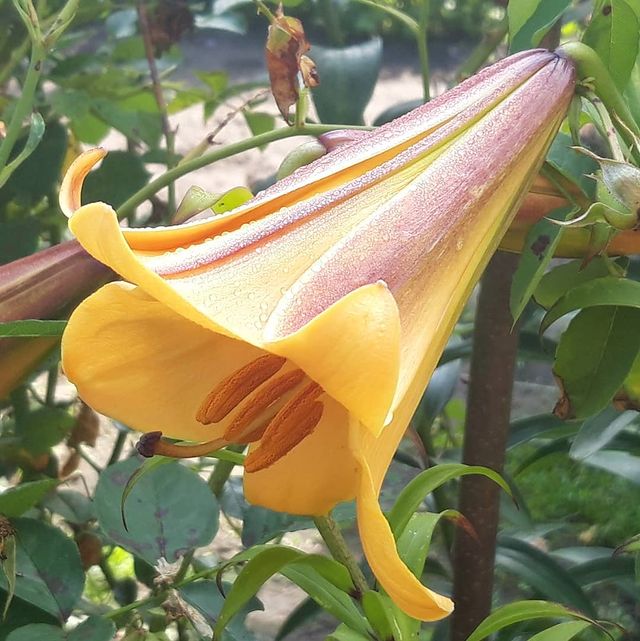
18. OT Hybrids
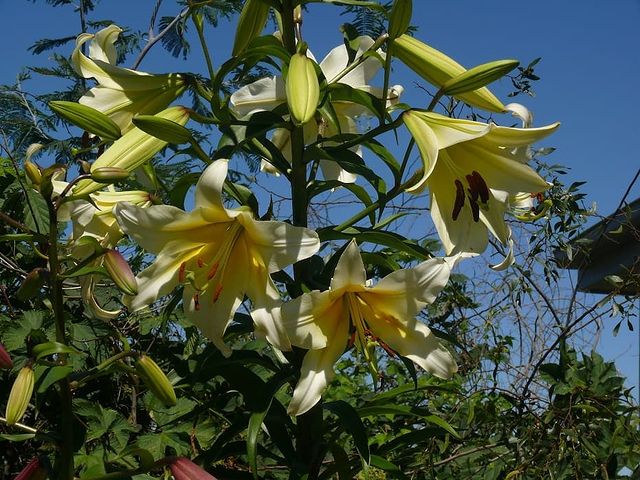
OT hybrids or Orienpet hybrids result from crossing Oriental lilies and Trumpet lilies. These are real giants among lilies as they grow up to eight feet tall and bear huge fragrant flowers almost ten inches long and wide that appear in mid or late summer. In short, OT lily is a plant that is impossible not to notice! Giant OT Zambezi of white flowers or Giant OT Altari with pink and white flowers are just some of these magnificent results of hybrid cultivation.
19. LA Hybrids
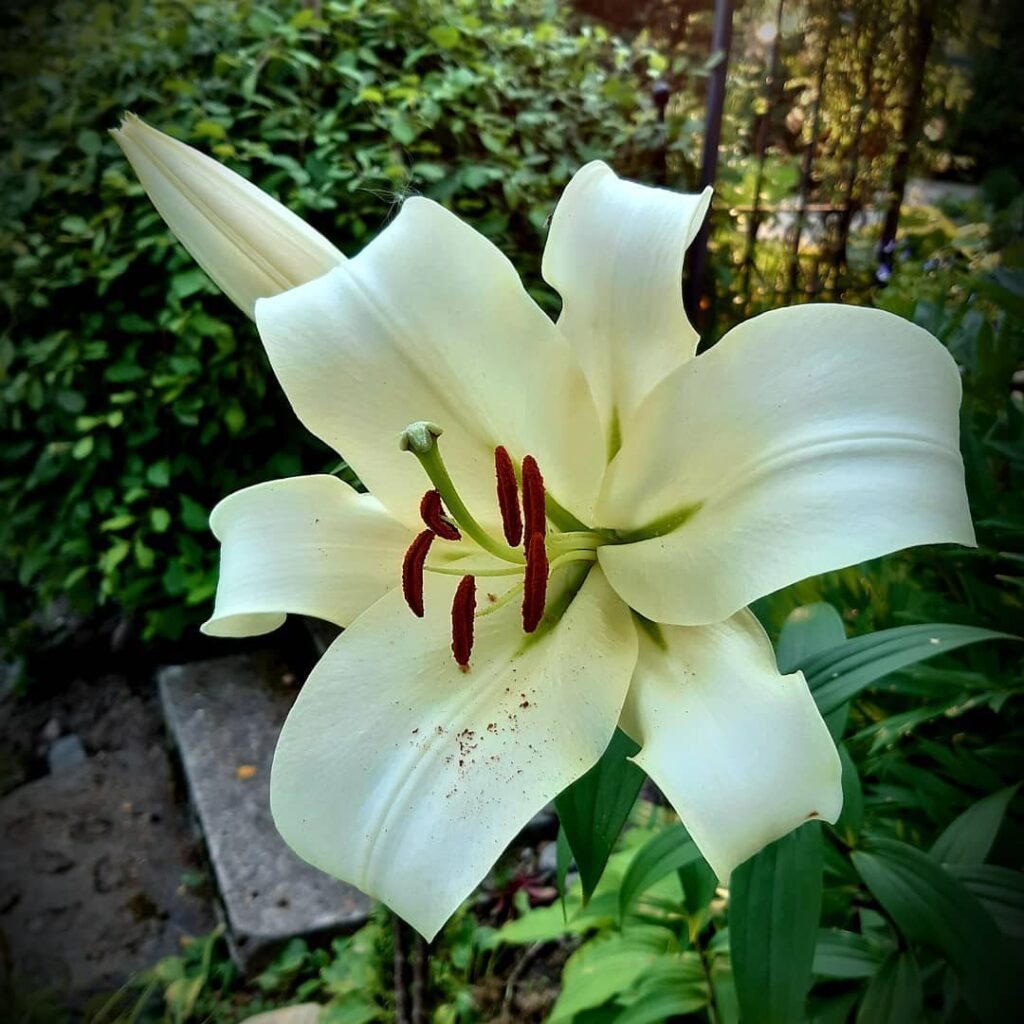
By crossing the Lilium longiflorum and Asiatic lilies, in 1992, the so-called LA hybrids of lilies were presented, combining the best of these species. Due to the genetic background of L. Longifolium, the flowers are long-lived and trumpet-shaped. The influence of Asiatic lilies is evident in a wide range of colors and outward-facing flowers. LA hybrid lilies are fragrant varieties that bloom in early to mid-summer.
20. LO Hybrids

These beautiful hybrids have emerged by combining the genetic material of Lilium longiflorum and Oriental lilies. ‘Bellsong’ shows all the beauty of the creation. It has enormous, bell-shaped bright pale flowers appearing early to mid-summer.
21. Oriental Hybrids
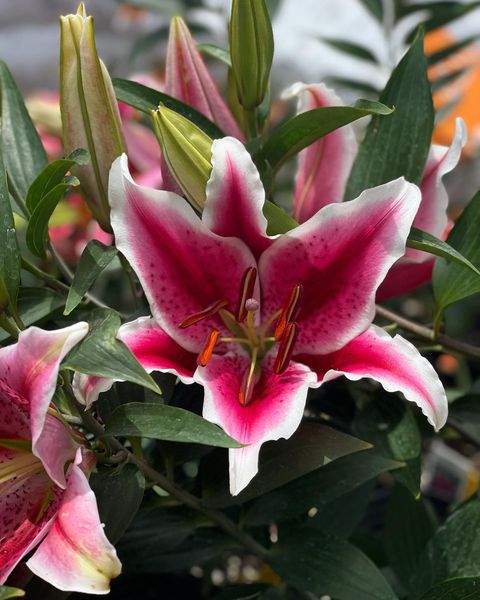
Derived from Lilium auratum and Lilium speciosum, oriental hybrids are the best of both Japanese native species.
Oriental hybrids grow up to seven inches tall and bear massive nine-inch long flowers with an enchanting scent.
On each stem, in mid to late summer grows up to eight bell-shaped flowers in different colors, often with dark freckles.
You can grow them as potted plants in spacy containers, although they are hardy and overwinter in the soil in climate zone 3 to 8.
‘Casablanca’ with delicate white flowers or ‘Dizzy’ with pink petals, framed with pale pink edges and scarlet freckles, are just some of the magnificent hybrids from this group.
22. Candidum Hybrids
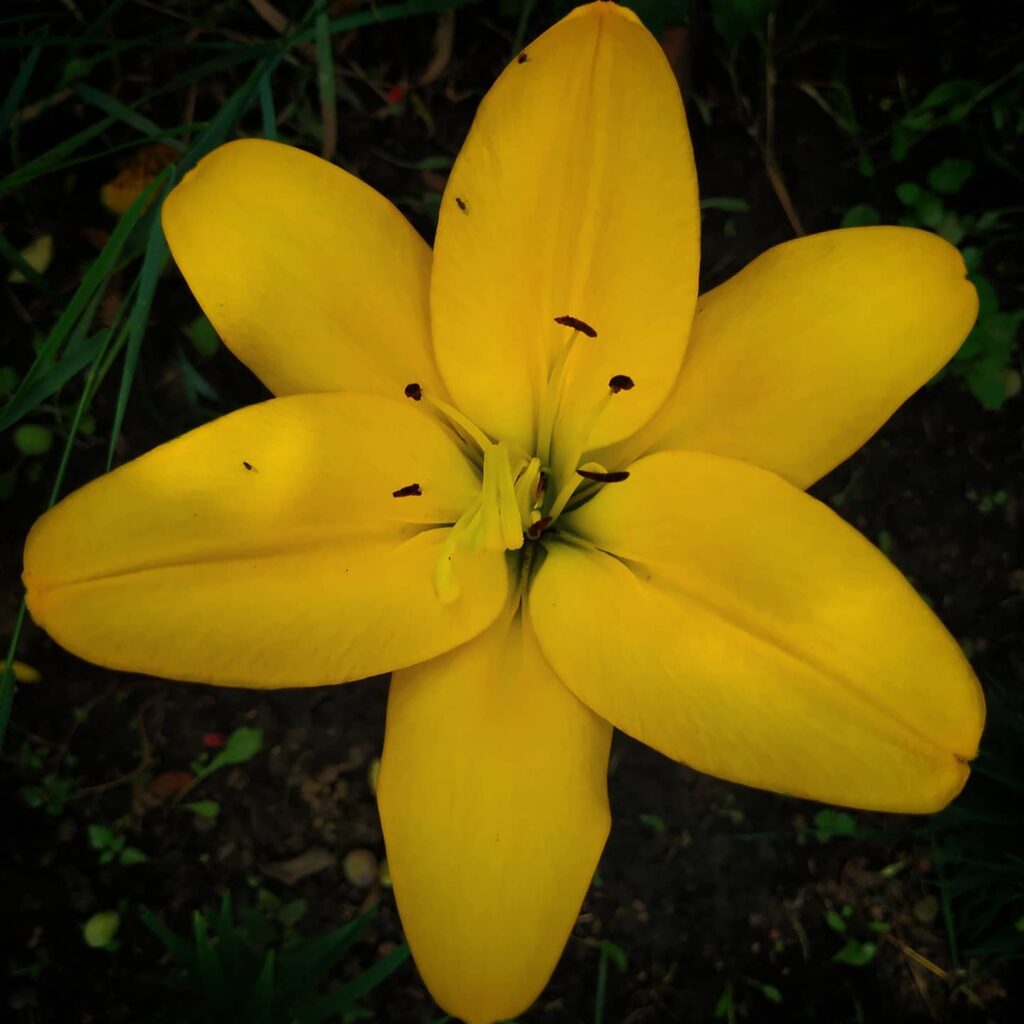
Candidum hybrids were formed by crossing Madonna’s white fragrant lily with other species to obtain plants with larger flowers.
The plants from this group can grow between three and four feet tall, bearing fragrant up to three inches long flowers.
Candidum hybrids bloom in late spring or early summer. Among the most popular are ‘June fragrance’ with creamy white flowers and Nankeen lily with yellow or pale orange nodding blooms.
Plants that share the name Lily
The name lily is common for many plants with bell-shaped or trumpet-shaped flowers, which, despite that name, are not part of the large Lilium genus. Here are some of them:
23. Canna Lilies

Canna lily is a spectacular upright summer flowering plant with large exotic tobacco-like leaves of pronounced veins and large, striking iris-like flowers in various colors.
The tuberous plant can grow three to five feet high and form a bush up to five feet wide.
Native to subtropical regions of Central and South America in the northern hemisphere, it is grown mainly as a potted plant or flower bed plant in the garden that you need to dig out at the end of the season and keep out of risk of low winter temperatures.
Despite its common name, it is not a lily nor has many similarities with plants from the lilies genus. It comes from the family Cannaceae, including only one genus with about ten plant species.
24. Calla Lilies

Calla lily does not belong to the genus Lilium, but by the exceptional beauty of its flowers, it can compete with lilies. Namely, this plant comes from the genus Zantedeschia from the family Araceae, originally from Africa and other tropical regions. Its unique flower consists of a single white, red, pink, or purple spathe that wraps up a yellow piston-like flower.
Calla grows from tubers, forming clumps of large, white dots with scattered leaves. Flowers on erect solid stems appear in midsummer until the first frosts. They are long-lived, so the Calla flower is a favorite in bouquets. The cut flower can also stay fresh for two weeks if the stem is pruned regularly.
If you live in the continental region, you need to remove calla tubers from the soil and store them in a frost-free space. It is not resistant to low temperatures and grows as a garden perennial only in climate zones 8 to 11.
25. Daylilies (Hemerocallis)
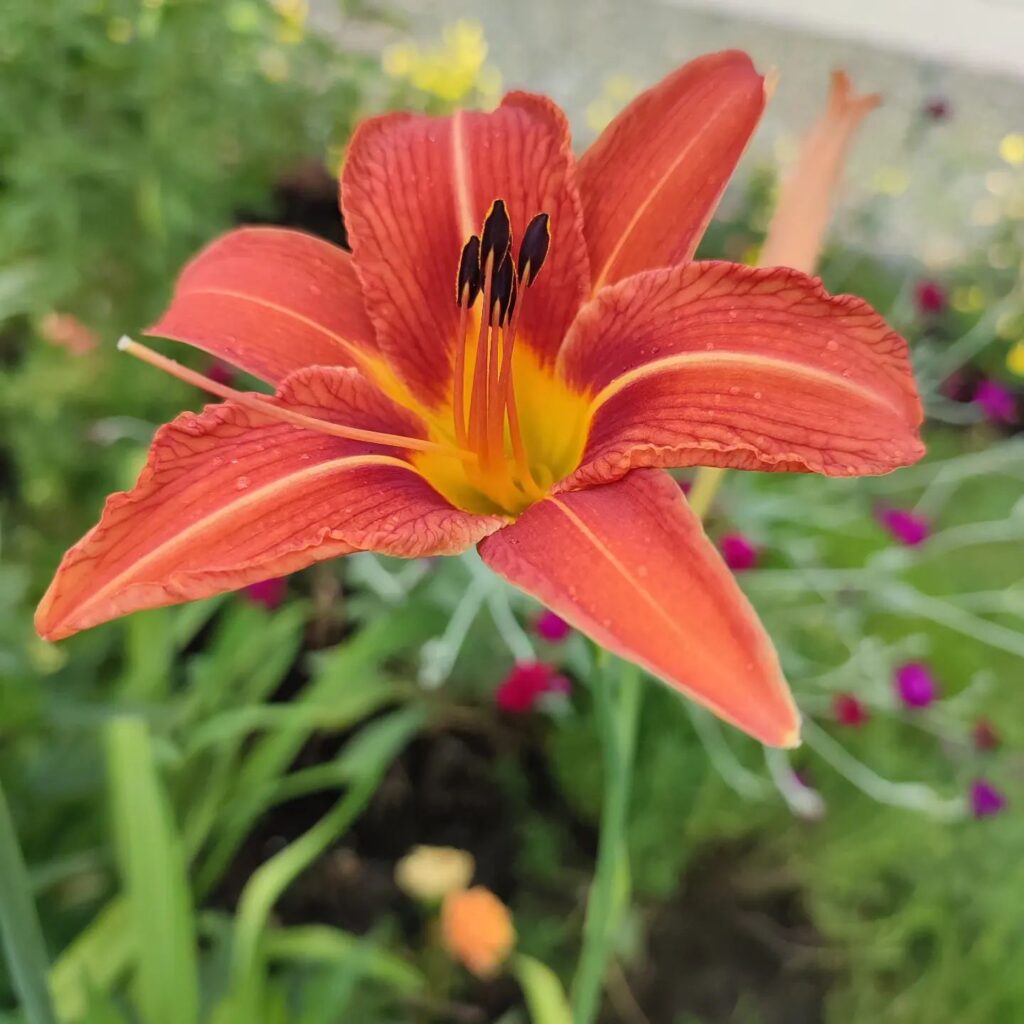
Hemerocallis or Daily lily is a hardy perennial of the Asphodelaceae family that grows from the rhizome root and forms clumps of narrow long grass-like leaves above which lily-like trumpet-shaped flowers appear throughout the summer.
Except for the shape of the flower, which explains the common name for this plant, Hemerocallis bears little resemblance to lilies. In addition, each flower lasts only one day and has no odor and from each clump emerge many raised stems bearing flowers smaller than in lilies.
26. Purple Rain Lily (Zephyranthes)
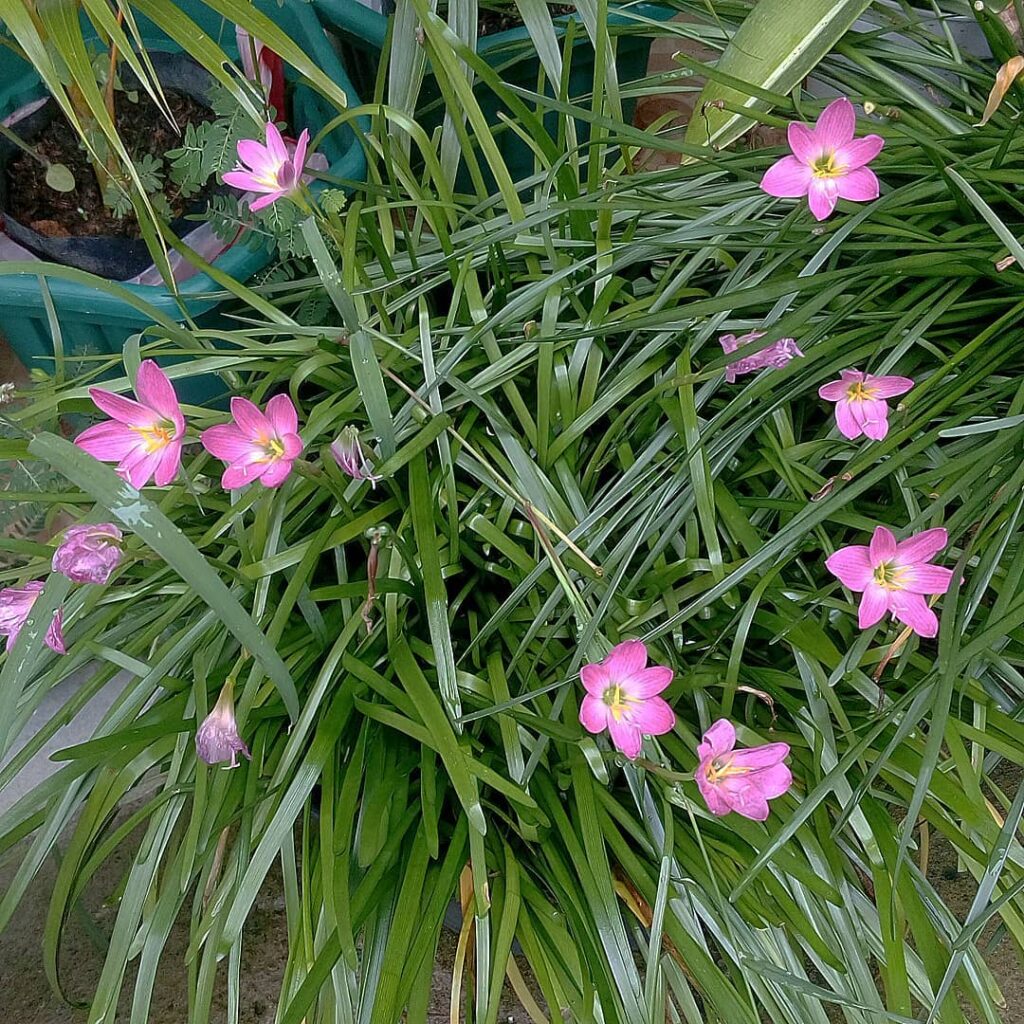
Purple rain lily is a plant of the genus Zephyranthes in the Amaryllis family. These are low, only one foot tall, bulbous plants native to Central and South America.
Unlike lilies, they grow in warmer regions and can spend the winter outside only in climate zones 7 to 11.
Diminutive, white, yellow, or pink flowers have six petals and appear in summer, usually after heavy rains, after which they got their name.
Frequently Asked Questions
What is the rarest type of lilies?
A: Lilium polyphyllum is an endemic species from the mountainous areas of Central Asia. It is also known as the Himalayan lily and is one of the endangered species.
Which lilies bloom the longest?
A: Asiatic lilies usually bloom for a month, even longer. But, if you want to extend the flowering season, you can plant species that bloom at different times to ensure flowering from spring to autumn.
Which lilies are the easiest to grow?
A: In general, lilies are not challenging to grow, but even among them stand out as a group of Asian lilies that can be effortlessly grown even by beginners.
What is the biggest lily flower?
A: OT lily ‘Big brother’ has one of the most prominent lily flowers. This large plant that grows 6 feet tall gives 11 inches wide fragrant lily flowers with snow-white petals and a yellow stripe on the trumpet’s throat.
Editor’s Recommendations
17 Stunning Yellow Orange Flowers (With Pictures)







